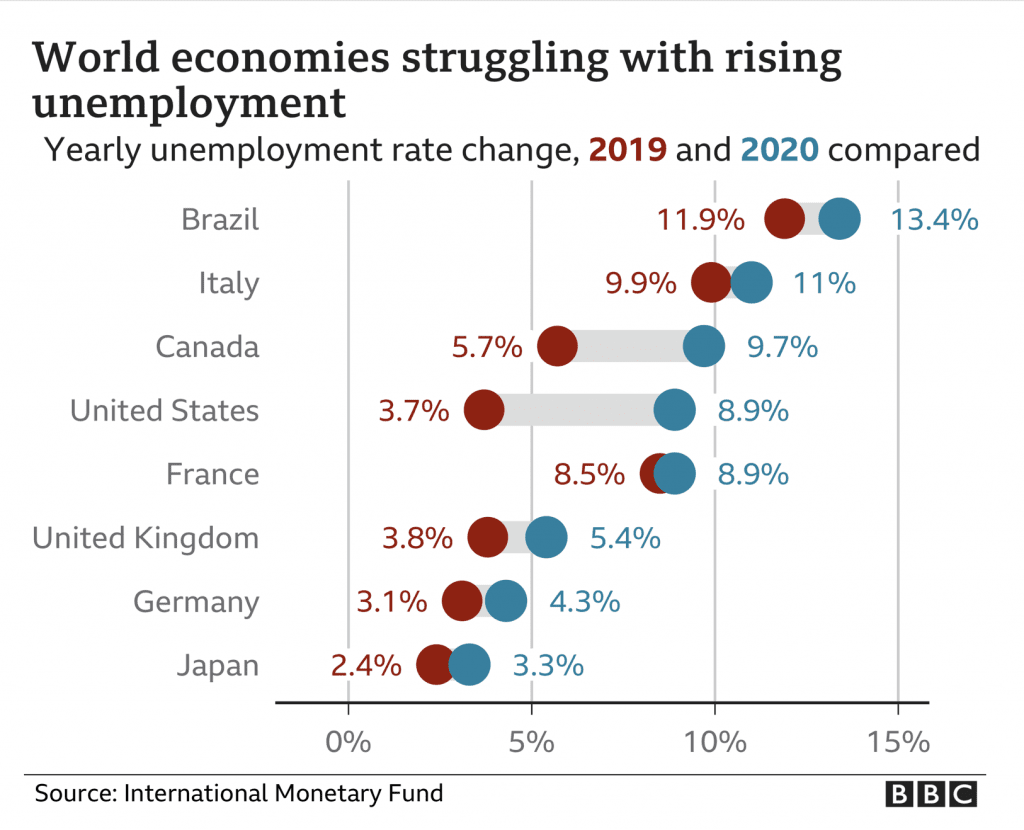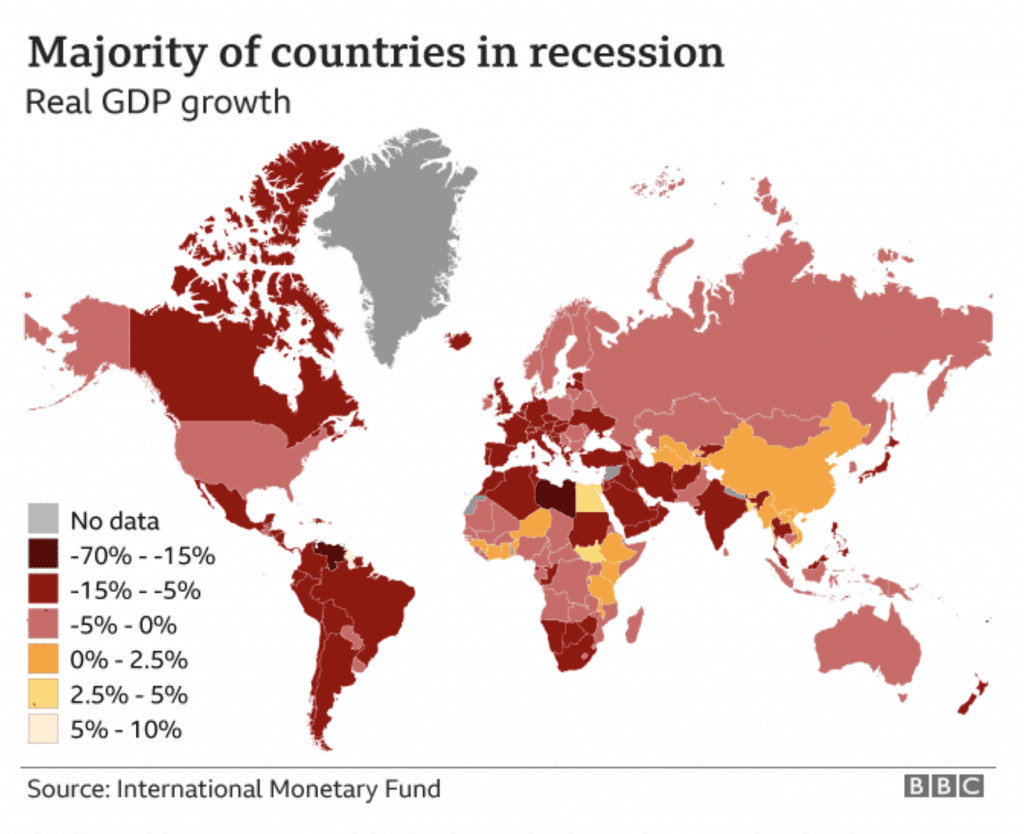Worldwide employment rate staggers from COVID-19’s impact.
By Larry Basinait
2020 was a year like no other. The United Nations estimates that the coronavirus pandemic caused the equivalent of more than a quarter of a billion lost jobs. The UN’s International Labour Organization (ILO) found that a full 8.8% of global working hours were lost in 2020 compared to the fourth quarter of 2019. That is equivalent to 255 million full-time jobs -a number “approximately four times greater than the number lost during the 2009 global financial crisis,” the ILO said in a statement.
“This has been the most severe crisis for the world of work since the Great Depression of the 1930s,” ILO chief Guy Ryder told reporters in a virtual briefing. Ryder stressed that another 81 million people did not register as unemployed but “simply dropped out of the labor market.”
The unemployment rate among Organization for Economic Co-operation and Development (OECD) countries spiked to 8.6% in the second quarter of 2020 from 5.4% in the first quarter, though it did fall to 6.9% in the fourth quarter.
It is forecasted that COVID-19 caused the global real GDP growth to decrease by 4.5% in 2020, or about $347 billion U.S. dollars, according to Statista. This decline is the worst since the Great Depression. The only major economy to grow in 2020 was China, registering a growth of 2.3%.
The International Monetary Fund is predicting global growth of 5.2% in 2021. That growth will be driven primarily by countries such as India and China, forecasted to grow by 8.8% and 8.2%, respectively. Recovery in big, services-reliant economies that have been hit hard by the outbreak, such as the UK, Italy, or Mexico, is expected to be slow, reports BBC News.
 In the fourth quarter of 2020, 40 of the 49 countries analyzed in the HRO Today report revealed increases in their national unemployment rates since the fourth quarter of 2019, while only four reported decreases and the remaining five remained unchanged. However, unemployment rate reporting by country varies greatly by accuracy and timing. Nearly every country examined in this analysis experienced a massive negative impact due to the worldwide pandemic.
In the fourth quarter of 2020, 40 of the 49 countries analyzed in the HRO Today report revealed increases in their national unemployment rates since the fourth quarter of 2019, while only four reported decreases and the remaining five remained unchanged. However, unemployment rate reporting by country varies greatly by accuracy and timing. Nearly every country examined in this analysis experienced a massive negative impact due to the worldwide pandemic.
In the largest economy in the world -the United States -GDP decreased by 3.5% in 2020, the largest decrease in GDP since 1946. On a quarter-by-quarter basis, GDP growth varied dramatically, decreasing 31.4% in the second quarter and increasing almost the same percentage in the third quarter. By the end of December, the U.S. economy recovered 12.4 million of the 22.2 million jobs lost during the pandemic, find Reuters.
United States and Canada
2020 was a volatile year for the United States economy. Prior to the pandemic, the unemployment rate reached its lowest point since 1969 at 3.5% in February. Once lockdowns came into effect in March to slow the spread of COVID-19, the unemployment rate shot to the highest rate on record in April, reaching 14.8%. Since that time, the unemployment rate improved to 6.7% in December, as about half of the jobs lost were regained, according to Trading Economics. Reflecting the roller coaster of a year, in the fourth quarter of 2020, the Worker Confidence Index decreased by 17 points from the fourth quarter of 2019 to 97.2.
According to the Bureau of Economic Analysis, the U.S. GDP decreased by 3.5% for the year after increasing 2.2% in 2019, the largest year-over-year decrease in GDP since 1946, finds CNBC. The yearly decline in GDP was led by a 13% drop in exports as global demand for goods and services fell. An increase in government spending offset the losses in other areas as the government provided fiscal stimulus to combat the economic slowdown.
The Canadian economy started to lose steam near the end of the year as employment shrank for the first time since April. In 2020, the GDP fell by 3.5% as personal consumption and business investment fell despite government expenditures increasing. On a year-over-year basis, the unemployment rate increased by 3.2 percentage points to 8.8% in the fourth quarter of 2020, reports Monthly Economic Monitor. Canada’s current unemployment rate lags behind the OECD and G7 averages that stand at 7.1% and 6.1%, respectively.
Asia-Pacific (APAC)
China is the largest economy in the region by far with a GDP of $14.3 trillion, which is also the second largest in the world. China was one of the few countries to have a “V” shaped recovery from the pandemic in 2020 and is the only major economy to grow in 2020, with a growth of 2.3%, according to BBC News. The reported unemployment rate in the fourth quarter of 2020 stood the same as it was one year ago at 5.2%, reports CNBC.
The Japanese economy, the second largest in the region, reported ongoing challenges in bringing down COVID cases, which held back consumer demand due to various restrictions put in place. However, fiscal policy along with strong external demand for goods and services should help prop up growth with the future, reports OECD. The unemployment rate increased to 2.9% in the fourth quarter of 2020 from 2.2% in the fourth quarter of 2019.
Europe, the Middle East, and Africa (EMEA)
The EMEA region covers three continents and includes 116 different countries which vary greatly in GDP and population. As evidenced throughout much of the world, there were mostly negative results in the fourth quarter of 2020 as unemployment rates increased in 20 of the 27 countries examined in this quarterly analysis. Saudi Arabia’s unemployment rate increased the most, up 2.8 percentage points since last year to 8.5%, driven by subdued oil demand. Conversely, Egypt and Turkey’s unemployment dropped the most since last quarter, down 0.8 percentage points to 7.2% and 12.9%, respectively.
In the fourth quarter of 2020, Reuters reports the Eurozone economy contracted by 5.4% on an annualized basis as pandemic-induced lockdowns weighed on growth. But despite the large contraction in GDP, the unemployment rate only increased by 1 percentage point from 7.4% in 2019 to 8.4% in 2020. The small increase in the unemployment rate was due to the large furlough schemes put in place to help employees stay employed and the measures to help corporate companies stay afloat, reports Deloitte.
Germany has the third largest population in the region at 83.9 million, but by far the largest GDP ($3.8 trillion dollars). In 2020, the German economy performed better than its European counterparts, contracting at a slower pace. The larger manufacturing and exporting base helped the economy continue to operate with less disruption compared to other service-based economies. However, the decline in GDP helped push up the unemployment rate from 3.3% in the fourth quarter of 2019 to 4.6% in the fourth quarter of 2020, reports The Guardian.
The United Kingdom has the second largest economy in Europe at $2.8 trillion dollars. The UK economy suffered its biggest decline in output in more than 300 years as GDP fell by almost 10%. With the decrease in GDP, the unemployment rate increased from 3.8% in the fourth quarter of 2019 to 5% in the fourth quarter of 2020.
Latin America
Latin America was far from spared by the economic crisis faced by other regions in 2020. In Latin America’s largest economy, Brazil, strong fiscal and monetary policy helped prevent an even deeper economic contraction from the COVID pandemic. Economic activity for the year fell by 6% as fixed capital formation and domestic demand decreased by 10.2% and 7.2%, respectively. OECD reports the unemployment rate increased from 11% in the fourth quarter of 2019 to 14.1% in the fourth quarter of 2020.
Mexico is the second largest country in the region, both by GDP and population. The sharp decline in the hospitality and tourism industry greatly damaged the Mexican economy. 2020 marked the second consecutive year of economic contraction as GDP fell 8.3% in 2020 after contracting 0.1% in 2019. Within the fourth quarter, a broad-based improvement within the economy from third quarter levels was viewed across most of the major sectors. However, a slow start to 2021 is expected as new restrictions in some states could weigh down the services sector. The most recent unemployment data states that Mexico’s unemployment rate currently stands at 3.8%.















